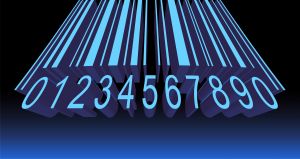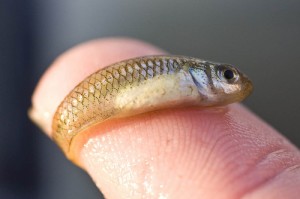By Katie Sinclair
Researchers on a jon boat in the middle of the Patuxent River were very excited to find a rainwater killifish in their crab tow. While not the juvenile crabs that the scientists were looking for, the inch-long rainwater killifish was an intriguing find: It was yet another species that could be “barcoded.”
Barcoding is another technique to answer the age-old question of what exactly lives in the Chesapeake Bay. By using trawls, seines and a fish weir, researchers at the Smithsonian Environmental Research Center (SERC) have a pretty good idea of what swims in our rivers and bays. But new DNA technology could give an even clearer picture on what species are present, as well as their role in the estuarine ecosystem.
We’re all familiar with barcodes at the mall or grocery store. Those black and white stripes can store all sorts of information. Barcoding DNA takes a similar approach: Certain DNA sequences in an organism pack a lot of information in a small package.
The barcoding project at SERC is a small subset of barcoding work being done at the Smithsonian and across many different institutions. The ultimate goal is to create a diverse database of thousands of species. Barcoding looks at mitochondrial DNA sequences several hundred base pairs long–enough material to be able to track differences across species, but short enough to sequence relatively cheaply. By comparing differences in the sequence, species can be identified.
DNA barcoding technology is particularly useful when identifying species that look very similar to each other. Scientists who are not taxonomy whizzes can use barcoding as a more reliable tool than subjective analysis of specific morphological traits (i.e. color patterns, body size and shape, etc.). Using DNA barcoding is useful in field studies as well. Instead of transporting whole specimens back to a lab for analysis or spending valuable field time on species ID, species can be identified with a small and easily transported tissue sample.
By creating a “bank” of DNA found at SERC, researchers will be able to readily identify specimens that are in less-than-ideal shape. At SERC, DNA barcoding is especially helpful when analyzing a fish’s stomach contents. It can be nearly impossible to identify what species are present in a stomach, since the digestive process destroys the specific physical traits that can help distinguish one species from another. By being able to identify everything that a species eats, more accurate food webs could be developed to show how energy moves up trophic levels.
Using DNA barcoding can also help SERC scientists discover how invasive species impact an ecosystem. For example, DNA barcoding can help them determine what effect invasive blue catfish have on the bay. By using DNA to identify stomach contents, they can compare the prey of invasive fish species to the prey of native species. Figuring out exactly what species the blue catfish eats can help researchers realize the effects of the blue catfish invasion.
But the main purpose behind the DNA barcoding project at SERC is even grander in scope: creating a comprehensive species database of the fish and invertebrates in Chesapeake Bay. This database, which will eventually have several hundred species, will prove invaluable to future scientists looking to understand life under the water.



